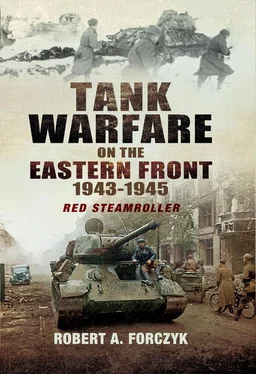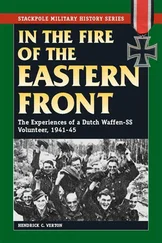Beyond the crushing quantitative imbalance, the failure of the much-anticipated Panther tank to deliver a qualitative solution to the Red Army’s numerical advantage was a severe disappointment for the Panzer-Divisionen. Although the Panther’s long 7.5cm KwK 42 gun had proven itself, the new tank’s mechanical unreliability prevented it from making more than a local impression; at the critical moment in December 1943, only 28 of PzAOK 4’s 139 Panthers were operational. {209}
Chapter 3
Armoured Operations in 1944
Heeresgruppe Nord retreats from Leningrad, 14 January–1 April 1944
For nearly three years, Heeresgruppe Nord had been holding its positions outside the city of Leningrad, with little change in the opposing lines. Although the Leningrad and Volkhov Fronts had opened a land corridor to Leningrad with Operation Iskra in January 1943, a year later the Germans were still within artillery range of the city. Generalfeldmarschall Georg Wilhelm von Küchler commanded Heeresgruppe Nord from his headquarters in Pskov and he had two armies: AOK 18 holding the lines around Leningrad and AOK 16 deployed between Novgorod and Velikiye Luki. Given the static nature of warfare on the Leningrad sector, the OKH had stripped Generaloberst Georg Lindemann’s 18.Armee (AOK 18) down to the bone during 1943. Several Luftwaffe Feld-Divisionen were sent to this relatively quiet sector, which allowed Heer infantry divisions to be sent southward and AOK 18 received far fewer personnel replacements than other German armies. At the start of 1944, Lindemann had 20 divisions holding a 280km-long front. In terms of armour, AOK 18 had relied upon the Tigers from s. Pz.Abt. 502 to repel enemy attacks and this unit enjoyed a considerable amount of success outside Leningrad. Oberleutnant Otto Carius was one of the Tiger ‘aces’ who made a name for himself in this Stellungskrieg (positional warfare).
However, on 6 October 1943, the Soviet Kalinin Front launched a massive attack near the boundary of Heeresgruppe Nord and Heeresgruppe Mitte. The 3rd and 4th Shock Armies, with a total of 16 rifle divisions and 300 tanks, attacked the II.Luftwaffen-Feldkorps near Nevel and rapidly achieved a major breakthrough. Both AOK 16 and PzAOK 3 were compelled to commit all their reserves to this endangered sector, to prevent the Kalinin Front from driving a wedge between the two German army groups. Von Küchler had to send his only mobile reserve, the Tigers of s.Pz.Abt.502, to support a counter-attack intended to retake Nevel and crush the Soviet penetration. The fighting around Nevel dragged on indecisively for months, although the Germans claimed that 1,450 Soviet tanks were destroyed in this sector over the course of the battle.
Despite the distraction of the Nevel breakthrough, by late 1943 the OKH assessed that the Soviet Leningrad Front would eventually attack Heeresgruppe Nord’s AOK 18 in force, so Obergruppenführer Felix Steiner’s III.SS-Panzerkorps headquarters was sent to join Lindemann’s command in ealy December 1943, along with 11.SS-Panzergrenadier-Division Nordland and 4.SS-Panzergrenadier-Brigade Nederland . Despite their grandiloquent titles, these recently-raised Waffen-SS formations were of mediocre quality, consisting primarily of Volksdeutsche, and poorly equipped. The Nordland ’s SS-Panzer Battalion 11 was supposed to be equipped with Panther tanks, but most proved defective and the battalion was still unready for combat in January 1944. {1} A few of the immobilized Panthers were sent to the front and dug in as strongpoints. Instead, the Nordland had SS- Sturmgeschutz Battalion 11 with 42 StuG III and the Nederland brigade had a battery with 10 StuG III. In order to increase its anti-tank capabilities, AOK 18 had also formed Panzer-Zerstorer-Bataillone 477 and 478, each equipped with 20 of the new 8.8cm Panzerschreck rocket launchers. As a contingency plan, Heeresgruppe Nord began construction of the Panther Line on 7 September 1943; the line was intended to run from Narva, behind Lake Peipus to Pskov and Ostrov. By the end of December, some anti-tank ditches and fieldworks were in place, but the bulk of the fortification effort would not be completed until March 1944. {2}
The main problem for AOK 18 was the Oranienbaum salient, which the Red Army had held since late 1941. This heavily-fortified salient was supplied by sea and forced AOK 18 to maintain at least a corps-size formation to contain it. Steiner’s corps was assigned to defend the southern side of the Oranienbaum salient, to prevent a link-up between the Soviet forces in Leningrad and the enclave. Nordland would serve as a mobile reserve for this critical sector. However, von Küchler and Lindemann were not particularly concerned about the Oranienbaum salient, which had been a quiet sector for two years. Instead, von Küchler and Lindemann focused on repelling a Soviet breakout from Leningrad toward the Pulkovo Heights. Once again, the Germans were let down by their poor intelligence support, which failed to note a shift in Soviet intentions. General-leytenant Leonid A. Govorov, commander of the Leningrad Front, was resolved to end the German threat to the city and to destroy AOK 18. Instead of attacking from the east, as he had tried in all previous offensives in 1941–43, this time Govorov decided to make his main effort from the Oranienbaum salient.
General-leytenant Ivan F. Fediuninskiy, a protégé of Zhukov, was put in command of the 2nd Shock Army, which consisted of seven rifle divisions, two tank brigades and three tank regiments. Fediuninskiy’s strike force was quietly moved into the Oranienbaum salient in late December; not all of this could be concealed, but the Germans failed to appreciate this as the Soviet main effort. Instead, the Germans focused on General-polkovnik Ivan I. Maslennikov’s 42nd Army, which was outfitted with nine rifle divisions, two tank brigades, six tank regiments and two artillery divisions. Golikov’s preparations were meticulous, and for once the Red Army was allowed adequate time for preparation. On the morning of 14 January, Golikov attacked. Fediuninskiy’s artillery commenced a massive artillery bombardment against the 9. and 10.Luftwaffe-Feld-Divisionen on the eastern side of the salient. Two Soviet battleships supported the attack, with 305mm naval gunfire. After smashing their positions with over 100,000 rounds in 65 minutes, Fediuninskiy then attacked with five rifle divisions and two tank brigades. Contrary to expectations, the Luftwaffe troops put up a stout defence that prevented an immediate breakthrough and enabled Nordland to send some reinforcements. At the same time, Maslennikov distracted the German L Armeekorps with a massive bombardment, which kept Lindemann from committing his limited reserves against Fediuninskiy’s 2nd Shock Army. As night fell, Fediuninskiy committed a mobile group consisting of Polkovnik Aron Z. Oskotsky’s 152nd Tank Brigade and two tank regiments to begin pushing toward the road junction at Ropsha.
On the morning of 15 January, Maslennikov’s 42nd Army attacked the L Armeekorps after another lengthy artillery bombardment and quickly achieved a 4km-deep penetration on the Pulkovo Heights. The breakthrough was assisted by the 36th and 49th Guards Tank Regiments, each equipped with 21 Churchill tanks. Meanwhile, Fediuninskiy smashed the remnants of the two Luftwaffe divisions but mobile group Oskotsky was stopped by a counter-attack from Nordland before it could reach Ropsha. Lindemann was able to organize local counter-attacks on 16–17 January that temporarily slowed the two Soviet armies that were advancing toward each other. Nordland employed its assault guns and mobile artillery to strike at the flanks of the Soviet penetration, but could not seal it off. Maslennikov formed a mobile group with the 1st and 220th Tank Brigades, but these were stopped north of Krasnoye Selo. However after five days of battle, the German defence began to crumble and the Soviet armies surged toward Ropsha. On 19 January, the 2nd Shock Army and 42nd Army fought their way into Ropsha, which isolated a number of German units and forced Lindemann to retreat. Adding to von Küchler’s problems, Meretskov’s Volkhov Front launched an attack against AOK 16 which overran a Luftwaffe division at Novgorod and threatened to unhinge AOK 18’s right flank, as well. Lindemann’s centre was pierced and both flanks were in retreat.
Читать дальше








![John Stieber - Against the Odds - Survival on the Russian Front 1944-1945 [2nd Edition]](/books/405234/john-stieber-against-the-odds-survival-on-the-russian-front-1944-1945-2nd-edition-thumb.webp)



